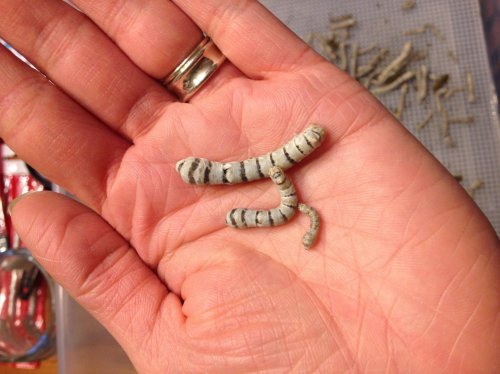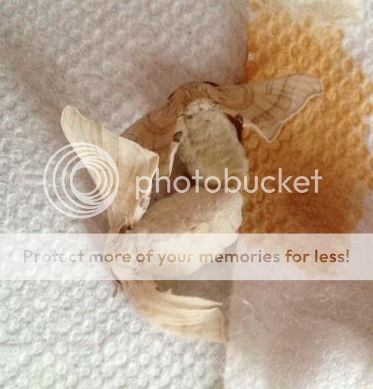Navigation
Install the app
How to install the app on iOS
Follow along with the video below to see how to install our site as a web app on your home screen.
Note: This feature may not be available in some browsers.
More options
You are using an out of date browser. It may not display this or other websites correctly.
You should upgrade or use an alternative browser.
You should upgrade or use an alternative browser.
I have a moth!!!
- Thread starter ridgebax1
- Start date
Psychobunny
Avid Member
I would just leave it in the box, the others will likely hatch soon, and mating will begin.
Take the cocoon out though, because they may lay eggs all over it!!
If they lay the eggs on a paper towel, you can just cut that patch out
later.
Take the cocoon out though, because they may lay eggs all over it!!
If they lay the eggs on a paper towel, you can just cut that patch out
later.
ellbodavis
New Member
So I looked in my cocoon box and lo and behold there was a moth!!! However one moth does not babies make! I hope a suitable mate hatches soon. Should I leave it in the box or move it somewhere else?
Excited for you and jealous!
I hatched 200 eggs almost two months ago. There are about 10 or so that have gotten huge and the others are not nearly as big. I hope I get some cocoon action soon.
pigglett79
Avid Member
So I looked in my cocoon box and lo and behold there was a moth!!! However one moth does not babies make! I hope a suitable mate hatches soon. Should I leave it in the box or move it somewhere else?
I leave them in there and take out the cocoon they cam eout of. Once you get some breeding, then you can move them around to where you want them to pay eggs.
oh man flying feeders sounds like a lot of fun. what kind of moths make good feeders?
If you want flying feeders, blue bottle flies are a hit. As for moths, many people feed wild caught moths or the moths from their silk worm and horn worm breeding projects. Silk worm moths do not fly though, but my boys do enjoy them every now and then.
Miss Lily
Chameleon Enthusiast
Cool! Silkmoths are so pretty! If its a female, it may well start laying before it gets chance to mate. If you get a pair, they will mate and staylocked for up to 24hrs if not longer. When they part the female will start to lay. I put a small plastic cup over my pairs so the eggs would be laid in a contained area. This pic shows a pair - female on the left, you can see how she emerges laden with eggs ready for fertilisation.

Here's a video I got showing how carefully she places the eggs next to each other.

Here's a video I got showing how carefully she places the eggs next to each other.
melble68
Established Member
Silk worm moths do not fly though, but my boys do enjoy them every now and then.
How weird that a moth doesn't fly. Did they evolve like some flightless birds did?
pigglett79
Avid Member
tks Trey. that makes sense.
but think about it this way. you eat some food, you meet a girl, the girl likes you, she likes you a lot for 24 hours, and then its over. don't sound so bad to me. actually would have sounded pretty good the way my last monday went.

They don't even eat.
Cap10Squirty
New Member
Excited for you and jealous!
I hatched 200 eggs almost two months ago. There are about 10 or so that have gotten huge and the others are not nearly as big. I hope I get some cocoon action soon.
Whoa! It's taking 2 months for the caterpillars to reach full size? Hey could you post picture(s) in your thread of the current size and how old they are (the latest batch you are raising?)
ellbodavis
New Member
Whoa! It's taking 2 months for the caterpillars to reach full size? Hey could you post picture(s) in your thread of the current size and how old they are (the latest batch you are raising?)
Let me clarify... I ordered them the end of October and it took two weeks for them to hatch so we are going on 4 weeks. It feels like it is taking forever. Here is a pic of the size differences. They are all from the same eggs. For some reason I also given "normal" eggs mixed in with these zebras that are all cream. I have about 50/50 zebra to normal.

pigglett79
Avid Member
Let me clarify... I ordered them the end of October and it took two weeks for them to hatch so we are going on 4 weeks. It feels like it is taking forever. Here is a pic of the size differences. They are all from the same eggs. For some reason I also given "normal" eggs mixed in with these zebras that are all cream. I have about 50/50 zebra to normal.
View attachment 90155
Oh yeah those still have a lot of growing to do before they will even think about making cocoons. Also with zebra silk worms the males are white and females are striped. So they are likely all zebra eggs, but some are just not striped.
Last edited:
ellbodavis
New Member
Oh yeah those still have a lot of growing to do before they will even think about making cocoons. Also with zebra silk worms the males are white and females are striped. So they are likely all zebra eggs, but some are just not striped.
Thanks! I had no idea about the color. Here I was thinking I got swindled. Is it normal for there to be such a size difference? Will the others catch up or will some delay cocooning?
pigglett79
Avid Member
Thanks! I had no idea about the color. Here I was thinking I got swindled. Is it normal for there to be such a size difference? Will the others catch up or will some delay cocooning?
Sometimes they can get bullied off the food and some are smaller. They could possibly catch up later, but you will probably end up with some cocooning days before others.
pigglett79
Avid Member
Oh, and the coloring is great because it lets you choose the biggest and best males and females for breeding.
Psychobunny
Avid Member
Pigglett, maybe u will know the answer, how can u tell the male moth from the female?
Also, isnt it best to wait until the silkworm is at it's largest size before letting it cocoon?
Seems like the bigger ones produce more eggs!?
But I have only been successfull breeding them twice, so I dont know
Also, isnt it best to wait until the silkworm is at it's largest size before letting it cocoon?
Seems like the bigger ones produce more eggs!?
But I have only been successfull breeding them twice, so I dont know
pigglett79
Avid Member
Pigglett, maybe u will know the answer, how can u tell the male moth from the female?
Also, isnt it best to wait until the silkworm is at it's largest size before letting it cocoon?
Seems like the bigger ones produce more eggs!?
But I have only been successfull breeding them twice, so I dont know
Males are more active, flutter their wings alot. Males have fuzzier antennae and are smaller in size. Females are bugger and usually not very active.

Generally the smaller silk worms that cocoon will be males and the larger worms females.
Similar threads
- Replies
- 4
- Views
- 717



